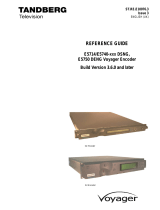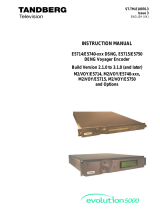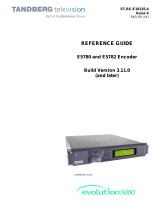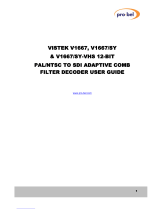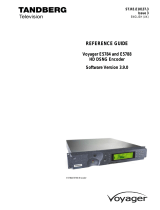Page is loading ...

Crystal Vision Ltd., Lion Technology Park, Station Road East, Whittlesford, Cambridge, CB22 4WL, England.
E-mail: [email protected] Website: www.crystalvision.tv Tel: +44(0) 1223 497049 Fax: +44(0) 1223 497059
SYN102
SDI Synchroniser

Crystal Vision SYN102UserManualR2.8
118/05/09
Contents
1 Introduction 3
Synchroniser mode 4
Delay mode 4
Analogue timing reference 5
Audio follow pulse 5
Freezing the picture 5
SDI loss behaviour 5
Vertical lock mode 5
Changing EDH options 5
2Statesman 6
2.1 Installing Statesman 6
2.2 Statesman operation 7
Selecting synchroniser or delay mode 8
Freezing the video 8
Loss of input behaviour 8
Vertical lock mode 8
Adjusting the video delay 9
3 Using the active control panel 10
3.1 Navigating the display 12
3.2 The SYN102 active panel menu structure 13
3.3 Using the timing menus 14
Vertical position timing 14
Horizontal position timing 14
Selecting the video standard 15
Selecting system options 15

Crystal Vision SYN102UserManualR2.8
218/05/09
4 Card edge operation 18
4.1 Reading card edge LEDs 18
4.2 Card edge switch settings 19
Changing the vertical lock mode 19
Changing EDH options 19
Using the manual freeze control 19
4.3 Card edge configuration 20
Vertical position timing 20
Horizontal position timing 20
Selecting the freeze type 21
Selecting the input fail mode 21
Selecting the video standard 21
Selecting the operating mode 22
Recalling factory defaults 22
Viewing the firmware issue no 23
5 Installation 24
5.1 Rear modules and signal I/O 24
RM02 24
RM01 25
RM18 25
5.2 SYN102 configuration 26
Selecting the reference input termination 26
Selecting EDH options 26
5.3 GPI connections 27
6 Problem solving 29
Card edge LEDs 29
The Statesman status display 29
Basic fault finding guide 30
7 Specification 31
Revision8. Termination link information amended. Page 27. 15-05-09

Crystal Vision Introduction
18/05/09 3SYN102UserManualR2.8
1 Introduction
The SYN102 is a serial digital synchroniser / delay module with up to four SDI outputs,
an audio follow output, and an input for an external analogue reference. It has two fields
of output timing adjustment and a short minimum delay of 2µs.
There are two operational modes: synchroniser and delay line. In synchroniser mode it
will automatically correct the incoming frame rate and any delay by taking its timing from
the analogue reference. Where input and output frame rates are locked together it can
synchronise sources containing embedded audio.
Delay line mode is ideal when the frame rate is correct but the source has been delayed by
processing.
SYN102 video synchroniser
The serial digital output has virtually no output jitter (less than 500ps at 1KHz), both
when used as a synchroniser (with a stable analogue reference) and when used as a delay
line without a reference. Only in delay mode can jitter on the SDI input affect the output,
but even then all high frequency jitter is removed by an internal phase-locked-loop.
When using 625-line video, picture disturbances on untimed input cuts are avoided by
waiting until line 23 to re-lock. The module regenerates all the video sync information in
its output data stream and will always produce legal video. It will pass ancillary data sync
word sequences, but not isolated sync word values.
There is a choice of black, or field/frame freeze on input failure.

Crystal Vision Introduction
18/05/09 4SYN102UserManualR2.8
The main features are as follows:
Frame or line synchroniser or use as a fixed delay line
Full vertical and horizontal adjustment from 0 to 2 fields in any mode
Fast lock after up-stream switch
Selectable black or freeze on input failure
EDH generation and error detection
Digital green suppression
Audio follow control output
Passes embedded audio (when output locked to input)
Removes SDI jitter
Flexible control
SYN102 is a 100mm x 266mm module, which fits in the three standard frames and can be
integrated with any boards from the company’s full product range. 12 modules fit in 2U, 6
in 1U or 2 in desktop box. It uses the RM01, RM02 and RM18 rear connectors.
Note: The Audio Follow Video pulse output, the duration of which reflects the current video
delay, is designed to be used with an external audio delay processor.
Synchroniser mode
In Syncro (synchroniser) mode the unit takes its timing from the analogue external
reference and will automatically synchronise sources with or without embedded audio
between 0 and 2 fields. Synchroniser mode is ideal for external sources that are not timed
to station references such as satellite or remote contribution feeds.
The timing can be adjusted through an entire frame using horizontal (fine) and vertical
(line increments) settings. When both settings are zero the serial output will be timed to
the analogue reference as per ITU-R BT.601. Increasing the vertical setting will delay the
output relative to the reference in increments of one video line. Increasing the horizontal
setting will increase this delay in samples or increments of 37ns. When the horizontal
setting reaches the end of a video line it wraps round and the vertical setting is changed to
provide continuous adjustment. In synchroniser mode the delay through the board
depends on this adjustment and the relative timing of the serial input and the analogue
reference.
Delay mode
In Delay mode, timing is derived only from the SDI input. Typical applications are where
a source passes through a processor such as a DVE, chroma keyer or standards converter
where the delay can be a few microseconds, multiple lines or up to two fields.
The timing can be adjusted through an entire frame using the vertical and horizontal
settings. When both settings are at their lowest the board will be set for the minimum
delay (input to output) of approximately 1.9 s. Increasing the vertical setting will
increase this delay in increments of one video line. Increasing the horizontal setting will
increase the delay in increments of 37ns. When the horizontal setting reaches the end of a
video line it wraps round and the vertical setting is changed to provide continuous
adjustment. The maximum setting of both controls will provide a delay of one frame plus
approximately 1.9 s.

Crystal Vision Introduction
18/05/09 5SYN102UserManualR2.8
In either mode the video delay remains fully adjustable over two complete fields. This
allows the output of the SYN102 to be timed into any edit suite irrespective of the timing
of the black and burst reference used in synchroniser mode.
Analogue timing reference
The SYN102 provides a synchronisation function that allows the digital output to be
timed to an analogue reference. Video or composite syncs can be used although
composite black and burst plus 300mV syncs into 75 Ohm as per EBU N14-1988 is
preferred. The analogue sync input can be looped through the board or terminated
depending on a jumper link setting.
Audio follow pulse
To allow an audio delay to track the delay through the SYN102, a TTL level pulse is
provided. This pulse is output every frame. The length of the pulse (the time between the
rising and falling edges) is the same as the delay through the store on the SYN102.
Freezing the picture
The type of picture freeze used when the freeze command is given may be selected from
frame, field 1 and field 2. If there is movement between both fields a frame freeze may
show movement judder. A field freeze works by repeating the same field to produce a
synthetic frame of video, without movement judder. However a field freeze is more likely
to show jagged edges on near horizontal lines.
SDI loss behaviour
Automatic freeze is available when input fails through loss of signal. The user can specify
to show the last good field repeated before picture failure, the whole frame in which
failure happened (useful for diagnostic purposes) or a black screen.
Vertical lock mode
With 525 line sources the re-lock is timed from the field flag to accommodate different
lengths of vertical blanking. Normally when operating with 625 line sources SYN102 re-
locks on the input at the start of active video. This means that if switch occurs between
untimed sources there will be no disturbance in the active video if both the sources are in
vertical blanking when the switch occurs. To allow operation with 625 line sources that
have non-compliant vertical blanking lengths, it is possible to select a re-lock timed from
the field flag.
Changing EDH options
Normally the EDH is passed through unchanged to the output. With card-edge lever 3 in
the DOWN position, EDH data on input can be overwritten with fresh EDH data. The
exact way new EDH data is generated and the behaviour of the card-edge EDH LEDs is
set by jumpers J3 and J4. Please refer to the Card edge operation and Installation chapters
for further information.

Crystal Vision Statesman
18/05/09 6SYN102UserManualR2.8
2 Statesman
The Crystal Vision Statesman PC control software is designed to control a range of
Crystal Vision modules via serial control from a PC.
The main Statesman application communicates with each module in a frame through an
active control panel with or without a LCD display. Statesman will not be able to detect
modules used in a frame with only a passive front panel.
2.1 Installing Statesman
Minimum pre-requisites:
A PC running either Windows 2000 or Windows XP is recommended
A parallel port dongle for Statesman PCs with attached Crystal Vision frames
An RS422 serial connection from the host PC to the Control/422 RJ45 or
Remote/RMT 2 connector on Crystal Vision frames
An active or Statesman enabled control panel MUST be fitted to the frame with
version 1.63 or above firmware – if it is an Indigo frame the firmware must be
V1.04 or above
An optional RS422 to RS232 converter if the PC has no RS422 ports
Installing Statesman
Refer to the readme and/or help file on the CD before proceeding
To view all application windows, set graphics resolution to at least 1024 x 768
Remove any previous version of the Statesman software using the Add/Remove
Programs application in the Windows Control Panel
Ensure that the Statesman dongle is fitted to the parallel port of the host PC
Insert the Statesman CD and the installation should start immediately – if it
does not, run the setup.exe file on the CD
Obey any installation program prompts and restart the PC when prompted
Running Statesman for the first time
The Statesman PC Control System may be run from the Crystal Vision programs folder
via the Start menu or by double-clicking on the Crystal Vision.exe file in the installed
program directory.
When the program runs it will require licence information and an administrator name and
password. It will also need to know which computer port is being used to connect to a
Crystal Vision frame(s).
Note: For further details of Statesman configuration please refer to the Statesman manual.

Crystal Vision Statesman
18/05/09 7SYN102UserManualR2.8
2.2 Statesman operation
Once Statesman is configured it should automatically detect any statesman compatible
modules in the connected frame or frames and display them in the main application left
hand explorer-style window.
Open any frame by clicking on the ‘+’ sign or by double clicking on a frame. Installed
modules should be shown with module icons. Frame and module icons can be named as
desired by right-clicking or using the edit menu and choosing rename.
To aid user recognition of module and frame status quickly, the following colour and size
coding is used:
A module is shown present by full colour and absent by greyed colour
A module is shown open by large icon size and closed by small icon
A module is the source of an active alarm if red and not alarmed if green
Double-clicking on a module will enable the display of the main application menus.
Statesman main application window
The two large control panes shown in the upper and lower halves of the window may
display different menus for the same card, or controls for different cards. Click on the
horizontal button-bar between the two panes to close the lower plane or drag the button to
vary the size of the panes.
Note: For further details of Statesman configuration and operation please refer to the Statesman
manual.

Crystal Vision Statesman
18/05/09 8SYN102UserManualR2.8
Selecting synchroniser or delay mode
The SYN102 may be used in either Syncro (synchroniser) or Delay mode.
To select the desired mode check either the Syncro for synchroniser or Delay for delay
mode.
SYN102 main properties
In Synchroniser mode the unit takes its timing from the analogue external reference and
will automatically synchronise sources between 0 and 2 fields.
In Delay mode, timing is derived only from the SDI input.
Freezing the video
The video signal may be frozen as a full fame (two fields) or single field. The field used
may be field 1 or field 2. Make the selection by checking the Frame, Field 1 or Field 2
box, then check the Freeze On box to freeze the input. The selection can be made before
or after the store is frozen.
Loss of input behaviour
The video display options when the video input is lost may be selected from the
following:
Loss of video option Video behaviour
Black Output goes immediately to black
Last field Last good field is repeated to produce a frame output
Last frame Last frame including video at point of failure
The selection can be made before or after the input is lost.
Vertical lock mode
Please refer to the Card edge operation and Installation chapters for further details.

Crystal Vision Statesman
18/05/09 9SYN102UserManualR2.8
Adjusting the video delay
The video delay may be adjusted from 0 to 2 fields for both 525 and 625 inputs in either
Syncro or Delay mode.
SYN102 main properties
Use the Delay in Lines and Delay in Samples controls to set the delay.
Delay control 625 range 525 range Description
Delay in Lines 0 to 624 0 to 524 Number of lines of delay in Delay
Mode or vertical timing offset with
respect to reference in Syncro mode
Delay in Samples 0 to 1727 0 to 1715 Fine delay or horizontal offset in
pixels in Delay Mode or fine vertical
timing offset with respect to
reference in Syncro mode
Note: The settings for 525 and 625 are retained when input standards change.
In delay mode, the minimum delay setting is 2 samples.

Crystal Vision Using the active control panel
18/05/09 10 SYN102UserManualR2.8
3 Using the active control panel
This operational guide assumes that the panel has been set up according to the Panel setup
procedure described in the Crystal Vision Controls Panel manual.
Note: It is ESSENTIAL that the Panel setup procedure is followed and any old or unknown
passwords cleared prior to using the panel for the first time.
At power up, the two line 20-character screen will display ‘Crystal Vision’ followed by
the firmware version number for the control panel. All eight control panel key LEDs will
illuminate.
The Crystal Vision control panel start up display
'Control Panel' then briefly replaces the version number display.
If the control panel firmware has been updated for Statesman control, Statesman Mode
will be entered and the message, ‘Press CAL to Exit’ will be displayed and the CAL LED
will light.
Statesman mode is entered by default
To continue with control panel operation or configuration, press the ‘CAL’ key once. A
second press of the ‘CAL’ key will return to Statesman control.
The control panel will display the name of the card that first responds to the polling
request together with its location number.
The location number consists of the frame number plus the card position in the frame.

Crystal Vision Using the active control panel
18/05/09 11 SYN102UserManualR2.8
Selecting the SYN102
To select a particular card in a frame, press the DEVICE key to go to the Device menu.
The top line of the display will show ‘Available Cards X’, where X is the number of
cards that have responded so far to the polling request.
Control panel showing available cards
Rotate the shaft encoder and the bottom row will display the successfully polled cards by
name and location or slot number.
In the example above, the card displayed is located in the first frame in slot number 2.
When the desired card is selected press the ENTER key to access that card’s HOME
menu.
SYN102 home menu
Note: In all current Crystal Vision frames the node address is coded into the backplane giving
a unique node address for each slot. The node address is typically one less than the
location number. Refer to the Frame manual for further information on using node
addresses.

Crystal Vision Using the active control panel
18/05/09 12 SYN102UserManualR2.8
3.1 Navigating the display
The functions assigned to control panel keys are dependent on the card selected for
control, and the panel mode. The following list illustrates the functions when controlling
the SYN102:
DEVICE – enters Device menu to select a card or card to control / enter Panel
setup when held down during power up / shows frame status when pressed from
Statesman mode
CAL – Enter or leave Statesman mode / enter Panel Diagnostics mode when held
down during power up
Asterisk – enters Board Rename menu from the Device menu
F1 to F4 – soft keys, function assigned within each menu
HOME – moves the display to the Home menu
ENTER – press to enable or disable data entry mode or accept device selection
Upward arrow – used to move up the menu structure / enter Lock Panel menu
from the Device menu
Rotary control – shaft encoder used to select options or change assigned data
values
Note: Please refer to the Crystal Vision Control Panel manual for details of the Panel Setup,
Lock Panel and Diagnostic menus.

Crystal Vision Using the active control panel
18/05/09 13 SYN102UserManualR2.8
3.2 The SYN102 active panel menu structure
The main top-level menus for the SYN102 module are obtained by pressing the F1 to F4
keys from the HOME menu. Menu keys are illuminated when active and when further
menus are available.
The following chart shows the available menus.
The SYN102 control panel menu tree
Menu numbering scheme
This manual uses a simple menu numbering convention based on the sequence of keys
required to reach each menu from the top level Home menu. For example, menu 1.4.1.2 is
reached from the Home menu by pressing F4, then pressing F2.
Sub-menus and data entry:
In general, press the ‘up’ key to return to a sub-menu and press the ‘home’ key to return
to the ‘home’ menu. The shaft encoder is used to change data values. There is no need to
press the ENTER key. An asterisk is used to indicate the active parameter.
Notes: Function keys and shaft encoder LEDs are illuminated when active.

Crystal Vision Using the active control panel
18/05/09 14 SYN102UserManualR2.8
3.3 Using the timing menus
Vertical position timing
Press F1 from the Home menu to display the Vpos (vertical position) menu.
The Vertical Position menu sets the number of whole lines the video is to be delayed in
Delay Mode, or the vertical timing offset with respect to the reference input in Syncro
Mode.
Vpos Adjust video timing in whole lines
The adjustment is made using the front panel shaft encoder.
The adjustment range is one video frame. When the maximum
adjustment is reached the value wraps round to zero.
Press the ‘up’ or ‘home’ key to return to the ‘home’ menu.
Note: There are separate vertical timing adjustments for 625 and 525 line operation. Each is
retained during operation in the other video standard.
In Delay mode the minimum total delay is 2 samples. If the horizontal delay setting is 0
or 1 sample, it will not be possible to set the vertical delay to 0 lines.
Horizontal position timing
Press F2 from the Home menu to display the Hpos (horizontal position) menu.
The Horizontal Position menu sets the number of pixels the video is to be delayed in
Delay mode, or the vertical timing offset with respect to the reference input in Syncro
mode.
Hpos Adjust video timing in pixels
The adjustment, in increments of 37ns, is made using the front
panel shaft encoder.
When the maximum adjustment of one video line is reached the
value wraps round to zero and the Vpos adjustment is modified.
Press the ‘up’ or ‘home’ key to return to the ‘home’ menu.
Note: There are separate horizontal timing adjustments for 625 and 525 line operation. Each is
retained during operation in the other video standard.
In Delay mode the minimum total delay is 2 samples. If the vertical delay setting is 0
lines, it will not be possible to set the horizontal delay to 0 or 1 samples.

Crystal Vision Using the active control panel
18/05/09 15 SYN102UserManualR2.8
Selecting the video standard
Press F3 from the home menu to display the Std (video standard) menu.
The available selections are ‘625’, ‘525’, and ‘Auto’. Selecting ‘625’ or ‘525’ will force
the unit to operate in the 625 or 525 line video standard respectively. Selecting ‘Auto’
allows the unit to auto-select the standard on the basis of the timing reference signal. An
asterisk indicates the selected option.
Std Select video standard
Press F1 for 625, F2 for 525 and F3 for AUTO.
Press the ‘up’ or ‘home’ key to return to the ‘home’ menu.
Note: There are separate timing adjustments for 625 and 525 line operation. Each is retained
during operation in the other video standard.
Selecting system options
Selecting the ‘Misc’ menu to choose three further sub-menus:
Fail - choose frozen field, frame or black in the event of input signal failure
Freeze – choose freeze type
Mode - Delay or Synchro
SYN102 Miscellaneous menu Description
Select F1 for the Fail menu, F2 for the Freeze menu and F4 for
the Mode menu.
Press the ‘home’ key to return to the ‘home’ menu.
Select F1, ‘Frame’ to output a frozen frame
Select F2, ‘Field’ to output the last good field received
Select F4, ‘Black’ to output digital black
Press the ‘up’ key to return to the ‘misc’ menu
Select F1, ‘Fld1’ to repeat field 1
Select F2, ‘Fld2’ to repeat field 2
Select F3, ‘Frm’to repeat last good frame
Select F4, ‘Live/Froz’ to toggle live/frozen status
Press the ‘up’ key to return to the ‘misc’ menu
Select F1 for Syncro mode
Select F3 for Delay mode
Press the ‘up’ key to return to the ‘misc’ menu
Press the ‘home’ key to return to the ‘home’ menu.

Crystal Vision Using the active control panel
18/05/09 16 SYN102UserManualR2.8
Selecting SDI loss behaviour
The SYN102 behaviour when the SDI input is lost may be selected to cut to black, freeze
or hold a freeze for a about a second before outputting a black screen.
Fail menu
If ‘Frame’ is selected the output will be a frozen frame up to and including the point of
failure. If ‘Field’ is selected the output will be the last good field received, frozen and
output twice to make up a full frozen frame. If ‘Black’ is selected the output will be a
digital black. An asterisk indicates the selected option. In any event the output will
continue to be a legal video signal. The freeze type can be selected before or after the
input is lost.
Freeze menu
Select the ‘Freeze’ sub-menu to choose the output when the synchroniser output is frozen.
The available selections are ‘Fld1’, ‘Fld2’, and ‘Frm’. If there is movement between two
consecutive fields a frame freeze may show movement judder.
A field freeze works by repeating the same field to produce a synthetic frame of video,
without movement judder. However a field freeze is more likely to show jagged edges on
near horizontal lines.
If ‘Fld1’ is selected, field1 of the frozen frame will be output twice. If ‘Fld2’ is selected,
field2 of the frozen frame will be output twice. If ‘Frm’ is selected the entire frozen
frame is output. An asterisk indicates the selected option that can be changed after the
freeze command.
An additional control is provided in this menu to switch the unit between live and frozen
video. The F4 key can be used to switch between ‘Live’ and ‘Froz’, the board will output
live and frozen video respectively. The unit will always power up in ‘Live’ mode.
The freeze type can be selected before or after the input is frozen.
Note: Freeze may be set to ON by manual control from edge of PCB, remote control panel,
Statesman control, or by asserting a GPI "Assert Freeze" input low.
Selecting the operating mode
The SYN102 has two modes of operation, synchroniser and delay line.
Selecting ‘Syncro’ configures the board as a synchroniser. The output video is timed
relative to the analogue reference. If the input and reference are running through whole
frames will be dropped or repeated as necessary. Selecting ‘Delay’ configures the board
as a delay line. The output video is timed relative to the serial input. An asterisk indicates
the selected option.
If the analogue reference is absent the board will automatically default to delay mode. If
there is no analogue reference or serial input the board will freerun to a factory set clock.

Crystal Vision Using the active control panel
18/05/09 17 SYN102UserManualR2.8
Selecting the vertical lock mode
This can only be accessed from the card edge. Please refer to the Card edge operation and
Installation chapters for further details.

Crystal Vision Card edge operation
18/05/09 18 SYN102UserManualR2.8
4 Card edge operation
The hinged front panel of the case reveals user control of the card, LED indication of card
status and an alphanumeric display.
The SYN102 front edge view
4.1 Reading card edge LEDs
Card edge LEDs may be used in conjunction with status information from any connected
remote status panel display or from Statesman if available.
Refer also to the trouble shooting chapter for more help with solving problems and
monitoring status information.
The following table summarises the card edge LED functions and colours:
Name Led
Colour Function when ON
+5V Green Illuminates when the board 5V logic supply is present
+3V Green Illuminates when the board 3.3V logic supply is present
Win Yellow Illuminates when the delay through the store is less than approximately
1.5ms
Frz Yellow Illuminates when the board output has been set to frozen
In Green Illuminates when the serial digital input is present
Ref Green Illuminates when the board output is timed to the analogue reference input
EDH0 Red EDH status flag 0. The meaning can be configured by jumper links
EDH1 Red EDH status flag 1. The meaning can be configured by jumper links

Crystal Vision Card edge operation
18/05/09 19 SYN102UserManualR2.8
4.2 Card edge switch settings
The 4-way piano switch allows the V LOCK, EDH and manual freeze options to be
selected.
Lever Up Down
1 V Lock
(625 only)
With a 625 line input the framestore relocks
vertically based on the SDI V-blank flag. This
allows switching on line 6 without disturbance
to the active picture
With a 625 line input the framestore relocks
vertically based on the SDI field flag. This
allows operation with equipment that does not
provide correct V-blank flag timing.
2Not used, leave up.
3 (EDH) EDH data in input is passed through to output. EDH data on input will be overwritten - output
will contain fresh EDH data generated in the
SYN102. EDH data is removed before the
flags are extracted.
4 Frz Output is live video. Output is frozen at the end of the next frame.
Changing the vertical lock mode
625 inputs
Normally when operating with 625 line sources SYN102 re-locks on the input at the start
of active video. This means that if switch occurs between untimed sources there will be
no disturbance in the active video if both the sources are in vertical blanking when the
switch occurs. To allow operation with 625 line sources that have non-compliant vertical
blanking lengths, it is possible to select a re-lock timed from the field flag.
Set lever 1 in the UP position to relock vertically using the SDI V-blank flag.
Set lever 1 in the DOWN position to relock vertically using the SDI field flag.
525 inputs
With 525 line sources the re-lock is always timed from the field flag to accommodate
different lengths of vertical blanking.
Changing EDH options
Normally the EDH is passed through unchanged to the output. With lever 3 in the DOWN
position, EDH data on input can be overwritten with fresh EDH data. The exact way new
EDH data is generated and the behaviour of the card-edge EDH LEDs is set by jumpers
J3 and J4. Please refer to the Installation chapter for further information.
Using the manual freeze control
Card-edge switch lever 4 can be used to force a manual freeze. The type of freeze will be
determined by the configuration currently active.
To freeze the output of the synchroniser place lever 4 in the DOWN position.
/
